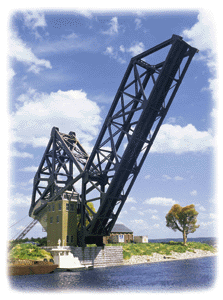The Walthers Cornerstone Operating Single-Track Railroad Bascule Bridge in HO scale is a top - pick among railroad engineers. Where railways and waterways meet, there's a lot of action, and lift bridges are common. The bascule design, hinged at one end, opens like a jackknife. It takes up less space, has fewer moving parts, can be partially opened for vessels of any size, and can be raised and lowered quickly, perfect for busy rail lines. This working model captures the real - life operation and fine details of actual bridges. It's sized right to handle big steam engines or modern double - stacks. The kit comes with detailed plastic parts showing all the rivets and cross - sections of the steel work. A large concrete counterweight mimics the massive lifting assembly of the prototype. The bridge tender's shanty high in the beams and a brick trackside interlocking tower add to the realism. Inside, there's a reliable low - speed motor that makes the bridge operate just like the real one. It's part of the Cornerstone Engineered Bridge System. Prototypes offer maximum clearance for vessels on busy waterways. It includes a low - speed motor and gear drive. You can add it to new or existing scenery with Single - Track Railroad Bridge Concrete Abutments (933 - 4551, sold separately) and use it with Walthers Code 83 Bridge Track (948 - 886, sold separately). It has clearance for today's taller equipment and features authentic trusses, chords, counterweight, and other details. It's molded in two colors and clear plastic. The finished model's dimensions are: Bridge Span & Approach 34 - 1/4 x 3 - 1/4 x 11' (86 x 8.1 x 27.5cm), Interlocking Tower Baseplate: 2 - 1/8 x 3 - 3/4' (5.3 x 9.3cm).

Using your Walthers Cornerstone Operating Single - Track Railroad Bascule Bridge is easy. First, if you have the Single - Track Railroad Bridge Concrete Abutments (sold separately), set them up in your desired location on your scenery. Then place the bridge on the abutments. Connect the Walthers Code 83 Bridge Track (sold separately) to the bridge. Plug in the power source to the low - speed motor inside the bridge, and you can start raising and lowering it just like a real bridge. When handling the bridge, be gentle with the plastic parts to avoid breakage. Keep the motor area clean and free from dust. If you notice any slowdown in the bridge's operation, check the connections of the motor and the gear drive. Store the bridge in a dry place when not in use to prevent damage to the plastic and metal parts. Enjoy creating an exciting railroad and waterway scene with your bridge!









